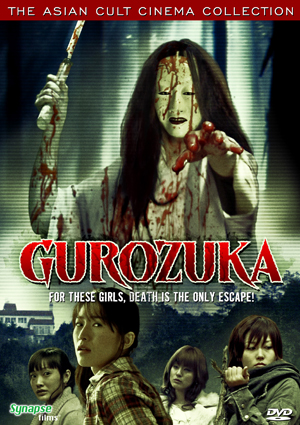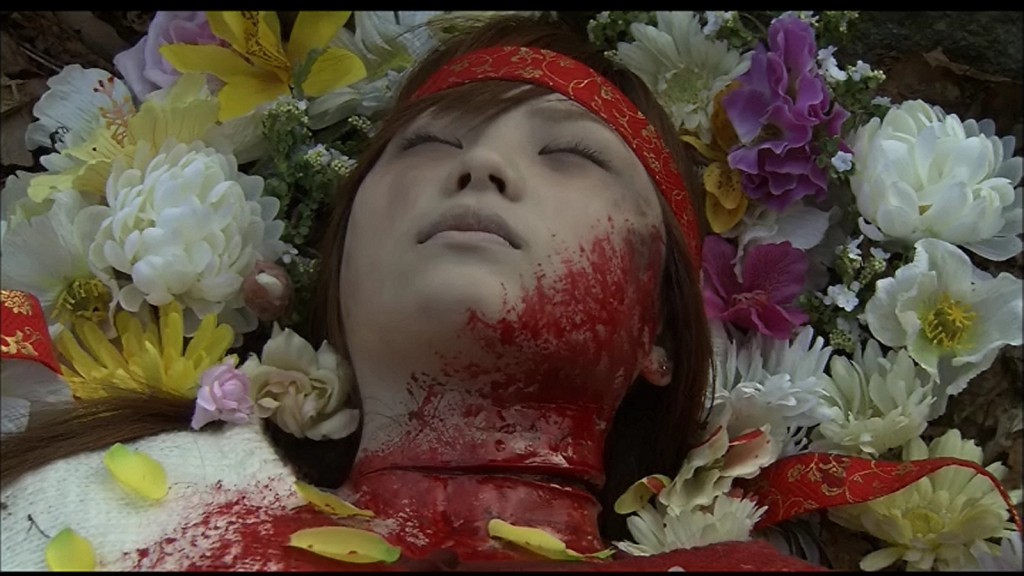GUROZUKA
 GUROZUKA
GUROZUKA
Yôichi Nishiyama, 2005
Released by Synapse Films
Review by Ariel Esteban Cayer
To say that Yôichi Nishiyama’s 2005 shot-on-video Gurozuka would not exist without Hideo Nakata’s 1998 Ringu is a complete no-brainer, but provides a good starting point for a discussion of this film, which was recently unearthed from the anonymity of J-horror derivatives by the fine folks at Synapse Films as part of their Asian Cult Cinema Collection and released on January 10th for Region 1.
While not strictly J-horror in my opinion – the supernatural entirely absent from the film’s and its horror completely devoid of any remotely similar atmosphere – Gurozuka inscribes itself right away in the tradition of J-horror narratives when a group of teenage girls, visiting an isolated country house in order to shoot an amateur film, soon find a DV tape depicting a killing by a mysterious killer wearing a deigan Noh theatre mask. In the same ways that the Ringu films brought the mythological figure of the long-haired yurei into the present, Gurozuka turns the deigan into a killer –– a ghost (woman) mad with jealousy, an emotion which is evidenced “by the gold flakes (dei) that form the pigment used around the eyes, [t]he gold pigment appear[ing] to sparkle like tears, representing the inner struggle of the character.”[1] Sadly all of this sounds infinitely better on paper, as Gurozuka fails to deliver atmosphere and tension, but most disappointingly, does not fulfill the promise of reflexivity that’s usually inherent to these films – especially when dealing with traditional texts, influences and imagery (Noh), technology (home video) and filmmaking (the film club the girls are in) within the same narrative – something that Hideo Nakata or Kiyoshi Kurosawa have been known to do beautifully in one way or viagra cheap fast shipping another.
Indeed, in Gurozuka, the various promising elements are never connected, as the film takes on the simplistic structure of the slasher film, as the girls’ already ill-fated production is innocuously sabotaged and they start getting picked off one by one. Gurozuka refuses to take its found tape or folkloric killer into account in any significant way. As best prices on generic levitra the investigation deepens, it is revealed that the killings are taking the 5-part structure of a Noh play (detail aurally reinforced by the minimal, cymbal-based soundtrack; conceptual enough to recall traditional Noh music but thoroughly irritating and ineffectual as a horror film theme), the complexities unfortunately stop there. Instead, most of the film is spent on the group of “frenemies” arguing and losing composure, as the film evolves – as most cabin-in-the-woods films do at some point, but more effectively than this – into a drama of relationships: someone steals the food; another adds poisonous mushrooms to the meal. It’s all very inconsequential and needless to say, interest steadfastly dwindles.
Weak slasher film parading as J-horror, most of Gurozuka’s stronger moments are subterfuge for an otherwise disappointing and quickly forgettable storyline that is mainly disappointing because it (in its synopsis, but also occasionally in its content) shows promise. Similarly, the DVD is slim on bonus features, offering a trailer (not really worth your time) and a making-of featurette that will only appeal to fans of the film – or the cute actresses, the most notable of which is gravure idol Yoko Mitsuya, seen in Sono’s 2005 Noriko’s Dinner Table and Kazuo Umezu’s Horror Theatre – as it’s constituted mostly of them going over some of the few memorable killings (a stretch) and complaining about lack of sleep and “cold” weather.
[1] Noh Masks Database, http://bit.ly/zPGeQJ

 February 1, 2012
February 1, 2012  No Comments
No Comments



